How Much Anchor Chain Do I Need to Anchor Securely?
In a Nutshell...
When you drop the hook, the length of anchor chain you let out—what sailors call the 'scope'—is a critical factor for a secure hold. As a rule of thumb, you need a minimum of four times the effective depth of the water (the depth of the water plus the height of your bow roller). But for real peace of mind, especially in normal conditions, you'll want to lay out a scope of 4:1 plus two times your boat's length. This is the best way to make sure your anchor holds fast, even if a strong gust of wind comes along.
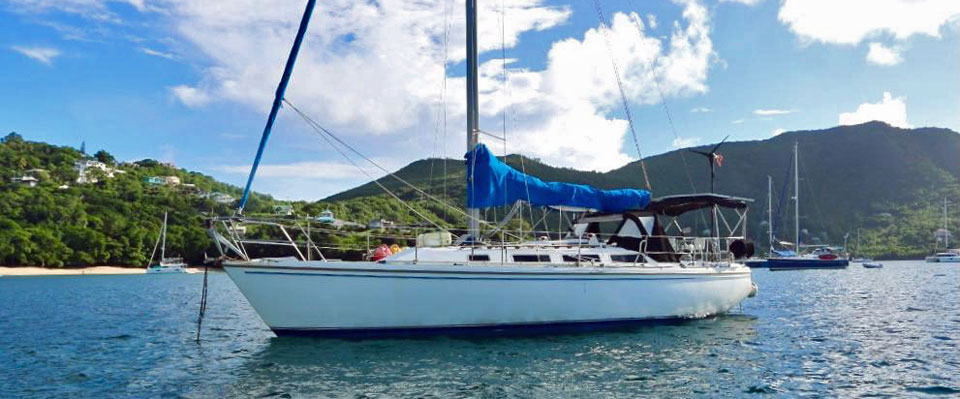 In calm conditions there will be little or no load on the anchor
In calm conditions there will be little or no load on the anchorTable of Contents
Getting to Grips with Anchor Chain Length
Dropping the anchor is one of the most fundamental skills you'll ever learn as a sailor. But if you're not careful, it's easy to get it wrong. The amount of chain you deploy, or 'scope', isn't just a matter of guesswork. It's the key to making sure your boat doesn't drag. Too little and you're in for a nerve-racking night; too much and you might find yourself swinging into the boat next door. The correct amount depends on a few important factors, including the water depth, tidal range, and the conditions you're anchoring in.
Working Out Your 'Effective Depth'
First things first, you need to figure out the effective depth. This isn't simply the number on your depth sounder. Unless you've set up your electronics differently, the display is usually showing you the distance from the transducer to the seabed. To get the full depth from the surface, you'll need to add that extra bit. Then, you've got to factor in the height of your bow roller above the water, because that's the point from which you'll measure the length of chain going into the water. If you don't add that extra height, you'll end up with a dangerously short scope.
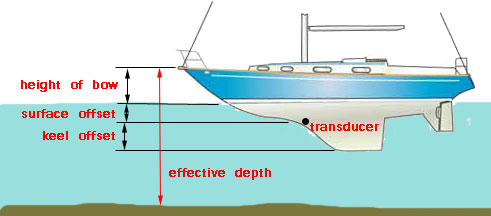 Is your depth sounder display giving you depth below transducer, keel or actual depth?
Is your depth sounder display giving you depth below transducer, keel or actual depth?The Science Behind a Secure Hold
For an anchor to do its job, the pull on the chain has to be horizontal. The anchor is designed to dig itself deeper into the seabed as a horizontal load is applied. If the pull on the chain becomes too vertical, the anchor's shank can lift up, and it's a short journey from there to it breaking out completely.
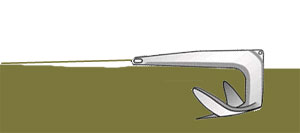 A Bruce anchor, well dug-in
A Bruce anchor, well dug-inThe Critical Angle The point at which the anchor is about to give up its hold is known as the critical angle. For most modern anchors, it's somewhere between 15 and 20 degrees. To stop this from happening, your scope must be long enough to keep that pull on the chain close to horizontal.
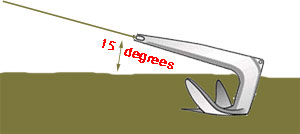 Same anchor, now about to break-out through having insufficient anchor chain length deployed
Same anchor, now about to break-out through having insufficient anchor chain length deployedThe bare minimum you need to lay out is a ratio of 4:1—in other words, four times the effective depth. That's the theoretical minimum to keep the pull horizontal. But let's be honest, that's just a starting point and doesn't leave you with a safety factor. In a blow, that minimum scope will just about hold, but it won't absorb any of the shock loads from gusts, which could pull your anchor free. When considering the broader subject of anchoring, remember that the amount of chain you deploy is just one aspect of a successful and safe experience. For a complete guide covering everything from selecting the right gear to advanced techniques for different conditions, be sure to consult our comprehensive resource, The Definitive Guide to Anchoring a Boat.
 Which situation would you feel most relaxed about?
Which situation would you feel most relaxed about?The Chain Length for 'Normal' Conditions
For most conditions, a 4:1 scope is a good rule of thumb. However, I always recommend using a snubber line. A snubber is just a length of stretchy rope—I prefer three-strand nylon or multiplait—attached to the anchor chain with a chain hook.
Why a Snubber is a Game-Changer:
- It absorbs the shock loads from gusts, which takes a lot of the stress off the anchor.
- It stops the chain from pulling taut and exceeding that critical angle.
- It keeps things quieter and reduces wear on your boat's bow roller.
Your snubber should be at least 10 metres long to be effective; those short little ones you see for sale are basically useless.
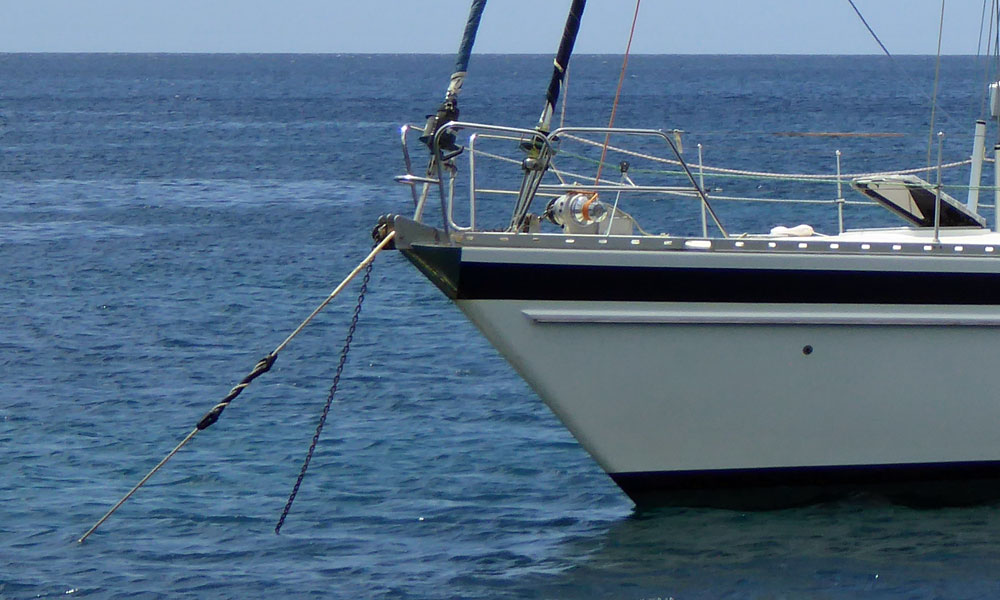 An anchor snubber doing its job
An anchor snubber doing its jobHow to Achieve Ultimate Security
For ultimate peace of mind, especially if you're leaving the boat or anchoring in an exposed spot, I've always gone with a more generous approach:
Lay out a 4:1 scope, plus an additional two times your boat's length.
This gives you a huge safety margin and ensures the catenary—the natural curve of the chain—will stay even in strong winds. The heavier the chain, the better the catenary effect, which acts like a big shock absorber. Of course, there's a limit to how much weight you want in your chain locker.
On my own boat, Alacazam, which is an 11.5m yacht, I carry 85m of 10mm high-tensile chain. It's a lot of weight, but it gives me serious holding power with a 20kg Rocna anchor. For those rare occasions when I need even more scope, I also have a 30m length of multiplait that I can shackle onto the end of the chain.
Practical Example: A 12m Boat Anchoring Securely
| Water Depth | Effective Depth | 4:1 Scope (Minimum) | Plus 2 x LOA | Chain Deployed (Ideal) |
|---|---|---|---|---|
| 3m | 4m | 16m | 24m | 40m |
| 5m | 6m | 24m | 24m | 48m |
| 10m | 11m | 44m | 24m | 68m |
What About Anchoring Stern-to?
While most of the time you'll drop anchor from the bow, there are times—especially in the Med—when you'll need to anchor stern-to the shore. In this case, you'd drop your anchor well out from the shore and pay out a lot of chain (for example, 70m in 30m of water), then tie your stern off to a tree or a rock ashore. This is a brilliant method because the anchor is just keeping your bow in line. Even if the wind were to shift and blow offshore, the anchor would have to drag 'uphill', so you'd still be perfectly safe.
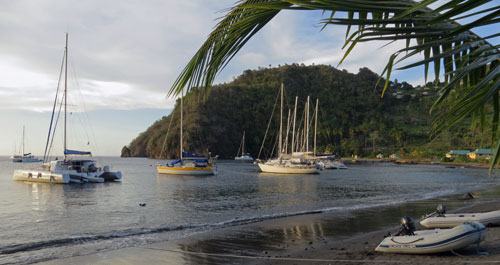 Anchored stern-to in Cumberland Bay, St. Vincent in the West Indies
Anchored stern-to in Cumberland Bay, St. Vincent in the West IndiesMy boat 'Alacazam', the yellow and white one in this pic, has its stern line tied to a palb tree ashore.
Summing Up
Learning to get your anchor chain length right is a fundamental skill that every sailor needs. It gives you the confidence & peace of mind to sleep soundly, knowing your boat is safe. While a minimum 4:1 scope is the basic rule, you'll be far better off adopting a more generous approach of 4:1 plus twice your boat's length. This, along with a good anchor and a proper snubber, is a winning combination for keeping your boat secure in any conditions.
This article was written by Dick McClary, RYA Yachtmaster and author of the RYA publications 'Offshore Sailing' and 'Fishing Afloat', member of The Yachting Journalists Association (YJA), and erstwhile member of the Ocean Cruising Club (OCC).
Frequently Asked Questions
What's the ideal scope for anchoring in a storm?
What's the ideal scope for anchoring in a storm?
For storm conditions, you'll want to increase your scope a lot. The old seadog's rule of thumb is 7:1 or even 10:1 if you've got the room for it. The greater the scope, the more horizontal the pull on the anchor, and the better the catenary effect to absorb those big shock loads.
Does chain diameter matter?
Does chain diameter matter?
Yes, it does. A heavier, larger-diameter chain gives you a better catenary effect, which helps absorb shock loads and keeps the pull on the anchor horizontal. You've got to find a balance between weight & practicality, of course. A 10mm high-tensile chain is a good choice for many cruising boats.
Can I use a rope rode instead of a chain?
Can I use a rope rode instead of a chain?
You can, but it's not ideal. Chain has weight, which creates that crucial catenary. Rope is buoyant and doesn't. If you have to use a rope rode, you'll need to use a much greater scope (7:1 or more) and attach a length of chain to the end to add some weight. Most sailors use a combination of chain and rope.
Is it better to have more chain or a bigger anchor?
Is it better to have more chain or a bigger anchor?
Both are important. A bigger, well-designed anchor gives you a better grip on the seabed. More chain provides the critical scope and weight for a horizontal pull. You need both to be effective.
How does the seabed type affect my anchor chain length?
How does the seabed type affect my anchor chain length?
The type of seabed is absolutely critical to how well your anchor holds. While your scope calculation stays the same, an anchor will hold much better in soft mud or sand than in hard gravel or rock. Always put some power on the anchor after you drop it to make sure it's properly set.
Recent Articles
-
Modern Boat Electronics and the Latest Marine Instruments
Dec 20, 25 05:27 PM
Should sailboat instruments be linked to the latest boat electronics as a fully integrated system, or is it best to leave them as independent units? -
Hans Christian 43: Classic Bluewater Cruiser & Liveaboard Sailboat
Dec 10, 25 04:37 AM
Explore the Hans Christian 43: a legendary heavy-displacement, long-keel sailboat. Read our in-depth review of its specs, design ratios, and suitability for offshore cruising and living aboard. -
Planning Your Sailboat Liveaboard Lifestyle: An Ocean Sailor's Guide
Dec 06, 25 05:18 AM
Seasoned sailors share their methodical risk analysis for planning a secure Sailboat Liveaboard Lifestyle, covering financial, property, and relationship risks.












